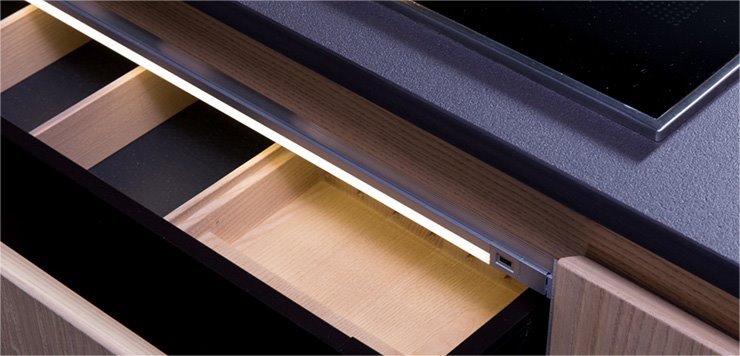Faq
Frequently asked questions and answers
On this page, you’ll find the most common questions about Lapitec.
If you have any other doubts or you cannot find the answer you're looking for, then please write to us!

Lapitec is a natural mixture of incredibly pure mineral powders, which are compacted together using exclusive, patented production technology; the result is large slabs with surfaces that are identical to their sides and centre.
What is Lapitec made from?

A mixture of selected mineral powders: Anorthite, Wollastonite, Mullite, Albite, Corundum, Zircon and Hematite.
Lapitec does not contain any resin or oil derivatives.
Lapitec does not contain any resin or oil derivatives.
Where can Lapitec be used?

Lapitec is suitable for an infinite number of applications.
Thanks to its format, it can be cut to any measurement required and, considering its physical-mechanical characteristics, it is suitable for the most common indoor and outdoor cladding solutions: paving, walls, façades, kitchens, bathrooms, tables, swimming pools and roofing.
Thanks to its format, it can be cut to any measurement required and, considering its physical-mechanical characteristics, it is suitable for the most common indoor and outdoor cladding solutions: paving, walls, façades, kitchens, bathrooms, tables, swimming pools and roofing.
How big are Lapitec slabs and how much do they weigh?

A full slab is 344 cm long and 154 cm wide.
Each slab measures just over 5 square metres and can be cut in a number of different ways.
Slabs are available in three different thicknesses: 1.2 cm, 2 cm and 3 cm.
Lapitec weighs around 30 kg per square metre (for 1.2 cm-thick slabs), 50 kg per metre for 2 cm-thick slabs and 75 kg for 3-cm thick slabs.
Each slab measures just over 5 square metres and can be cut in a number of different ways.
Slabs are available in three different thicknesses: 1.2 cm, 2 cm and 3 cm.
Lapitec weighs around 30 kg per square metre (for 1.2 cm-thick slabs), 50 kg per metre for 2 cm-thick slabs and 75 kg for 3-cm thick slabs.
Why is Lapitec a unique material?

25 patents certify just how exceptional this product really is. There are no other materials like Lapitec, as it is created and manufactured in Italy, in just one, latest-generation production plant.
Lapitec has also achieved the most important certifications in terms of performance and environmental sustainability, with reference to the main international protocols, such as the ‘Green Guard Gold’ and ‘NSF’.
Lapitec has also achieved the most important certifications in terms of performance and environmental sustainability, with reference to the main international protocols, such as the ‘Green Guard Gold’ and ‘NSF’.
How many colours does Lapitec come in?

There are 17 different shades, available in 6 different surface textures, creating over 100 possible combinations.
How can I work with Lapitec?

Lapitec can be sandblasted, bush hammered and satin-finished. Different types of borders/edging can be made that can adapt to various styles; the most sophisticated processing techniques, such as engraving, inlays and 3D logos, are also possible.
Can anyone work with Lapitec?

Thanks to the Lapitec Academy, we select and certify fabricators after specific training is provided.
Training sessions give stonemasons all the know-how they need to work the material, making them “Lapitec Approved Fabricators”. To date, there are thousands of these approved fabricators across the world, creating a network that ensures the best possible processing quality for Lapitec surfaces.
Training sessions give stonemasons all the know-how they need to work the material, making them “Lapitec Approved Fabricators”. To date, there are thousands of these approved fabricators across the world, creating a network that ensures the best possible processing quality for Lapitec surfaces.
Can Lapitec get stained or scratched?

Lapitec is a hygienic material: it prevents dirt, bacteria and mould from building up and requires minimum maintenance. It is easy to clean and is also highly resistant to scratches and abrasions.
Can I place hot pans on a Lapitec surface?

Yes, because Lapitec is resistant to thermal shocks, and therefore to high temperatures; it is therefore perfect for use in the home, especially in the kitchen.
Does Lapitec wear out over time?

Lapitec is not subject to wear and tear.
It is resistant to UV rays and is particularly recommended for outdoor applications.
Furthermore, thanks to its hardness, it is also suitable for paving that is walked on a lot.
It is resistant to UV rays and is particularly recommended for outdoor applications.
Furthermore, thanks to its hardness, it is also suitable for paving that is walked on a lot.
Is Lapitec fireproof and frost-resistant?

Lapitec is fireproof and has an ‘A1’ reaction to fire. Furthermore, Lapitec does not get damaged by frost or very low temperatures. It is imperishable over time and is resistant to weather conditions.
Is Lapitec green and recyclable?

Lapitec is a 100% natural product because it does not contain any oil derivatives, ink or varnish. That’s why it is a fully recyclable material and has a reversible life cycle.
Lapitec can be disposed of like a normal inert material.
Lapitec can be disposed of like a normal inert material.
Can Lapitec bend?

Lapitec cannot bend, as it comes in large, identical slabs that undergo strict testing in terms of their planarity. Each slab is extremely planar and its surface may have deformations of up to a maximum of around 3 mm on a 3 metre-long slab.
What is the difference between Lapitec and normal ceramic/quartz?

To all intents and purposes, Lapitec represents the technological evolution of common ceramic/quartz agglomerates. Unlike quartz, Lapitec does not contain resin or other chemical products that may deteriorate over time and, unlike ceramic, it has no surface printing.
How are Lapitec’s surface finishes made?

After being baked at incredibly high temperatures, the slabs - depending on the required texture - are given the right thickness and are polished, given a satin effect, bush hammered or brushed. The surfaces of Lapitec slabs are therefore not decorated with prints or glazes.


.jpg)
.jpg)
.svg)